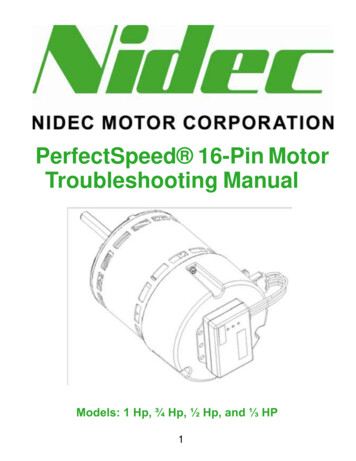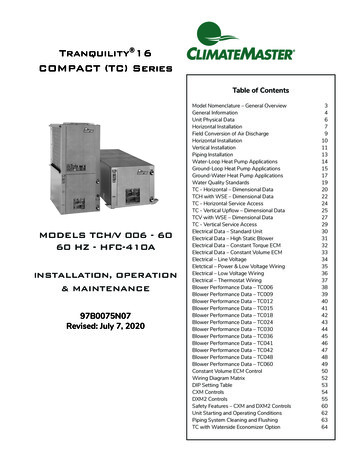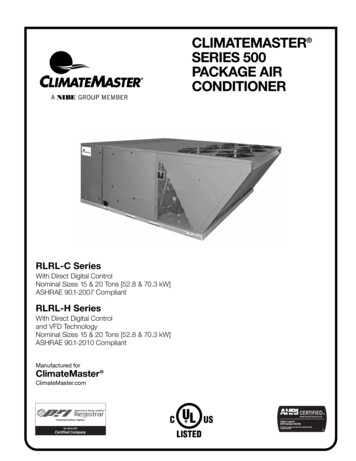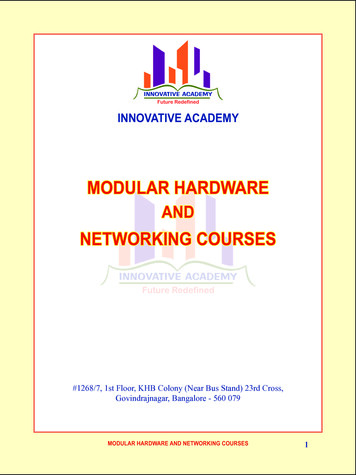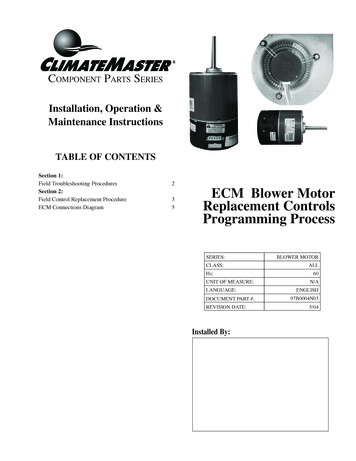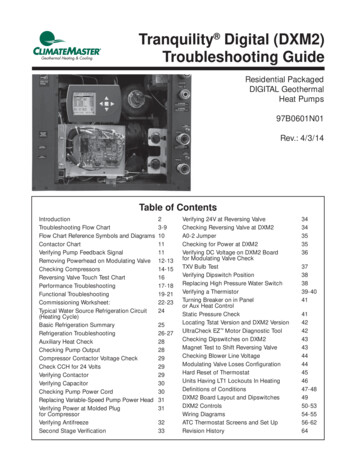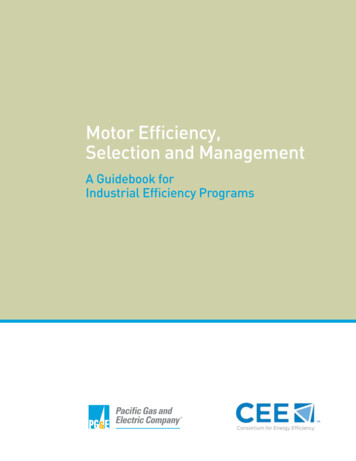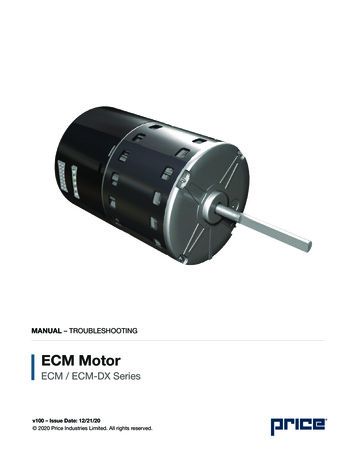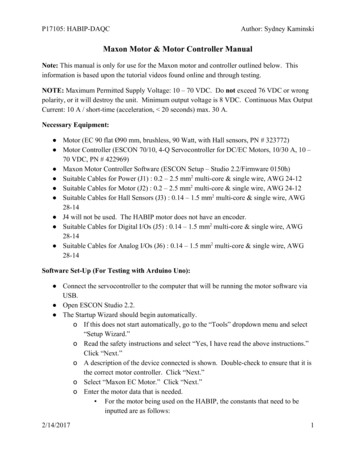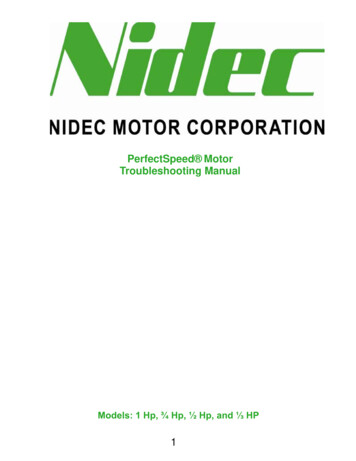
Transcription
PerfectSpeed MotorTroubleshooting Manual1
Table of ContentsAbout the PerfectSpeed Motor.3Important Safety Information.5Getting Started.9Basic troubleshooting.9Check 1 : Diagnosis with UltraCheck-EZ Diagnostic Tool .10Check 2 : Electrical Troubleshooting.13Check 3 : Control Unit Verification.15Check 4 : Motor Verification.182
About the PerfectSpeed MotorThe PerfectSpeed Variable Speed Motor is a 4-wire electronically controlled motor. Its two-waycommunication provides automatic configuration and checking of system settings to ensure thecustomer better comfort, efficiency, and higher reliability. The PerfectSpeed motor providesefficient “soft” start-and-stop and automatically adjusts its speed to precisely match humidity andtemperature needs. The end result for homeowners is enhanced energy efficiency and homecomfort.About Nidec Motor Corporation:Nidec Motor Corporation (NMC) is a leading manufacturer of commercial, industrial, and appliancemotors and controls. The NMC product line features a full line of high efficiency motors, large andsmall, which serve industrial, residential and commercial markets in applications ranging from watertreatment, mining, oil and gas and power generation to pool and spa motors, air conditioningcondensers, rooftop cooling towers and commercial refrigeration. It also makes motors, controls andswitches for automotive and commercial markets. Brands include U.S. Motors , SR Drives ,Hurst , Rescue , ECOTECH-EZ .Parent company Nidec Corporation (NYSE: NJ) is the world’s leading manufacturer of smallprecision motors, including motors used in hard disk drives and optical disk drives. The companyhas extended its focus beyond the information storage motor market to the home appliance andautomotive markets, where it sees high future growth potential.For more information, visit www.nidec-motor.com.3
PerfectSpeed Variable Speed Motor AssemblyMotorControlGeneration IGeneration II4
Important Safety InformationOnly trained and qualified professionals familiar withPerfectSpeed motors should service the motor and controlunit.Before connecting or disconnecting cables or other electricalconnections, verify power is shut off to the system. Failureto comply may cause serious damage to the motor, HVACsystem or injury to personnel.Because the risk of electric shock, only individualsthoroughly trained in the use of multimeters should conductvoltage tests.Never touch the metal contacts on the multimeter during aTest.Always check testing equipment for proper operation beforeUse.All aspects of the installation must conform to the applicablerequirements of the NEC (National Electric Code), includingArticle 430 (Motor Circuits and Controllers), as well as alllocal codes.5
Safe installation, operation and maintenancemust be performed by qualified personnel. Familiarizationwith and adherence to the National Electric Code, NFPA(National Fire Protection Association) standards and localcodes is required. It is important to observe safety precautionsto protect personnel from possible injury. Personnel should beinstructed for handling each of the following:Insulate all connections carefully to prevent grounding orshort circuits. Reinstall all conduit and terminal box covers.Voltage to the motor control must be within plus or minus10% of the nameplate voltage to avoid overheating and lossof performance.Make sure the unit is electrically grounded and properelectrical installation wiring and controls are used consistentwith local and national electric codes. Refer to “NationalElectrical Code Handbook ”& NFPA No. 70. Employ qualifiedelectricians. Insulate all connections carefully to preventgrounding or short circuits. Reinstall all conduit and terminalbox covers.Code requirements differ from state to state. Installequipment in accordance with the applicable codes andordinances in your area and in accordance with the NationalElectrical Code. All electrical connections should be madeand maintained by a qualified or licensed electrician.Make sure there are no unusual noises or vibrations whenthe motor is running. If noise and vibration are observed,refer to the Troubleshooting section.Avoid contact with energized circuits or rotating parts.Provide proper safeguards for personnel against rotatingparts.6
Always disconnect electrical power at thefuse box or circuit breaker before handling electricalconnections or performing maintenance on this unit.Allow the motor to come to a complete stop. Doublecheck to make sure power is OFF, and that it cannotbe turned on while you are working on the equipment.Wait 2 minutes before handling the Power Cord. Thisallows the bus capacitors to fully discharge.A poor electrical connection can overheatand cause terminal and/or terminal board failures. Becauseof this possibility, wiring harness quick-connect terminalsshould be examined carefully for any signs of physicaldeterioration or loose fit to the terminals on the motorterminal board. If there is evidence of loose fit ordeterioration, quick-connect terminals should be removedfrom the wiring harness and the harness wires thenconnected directly to the motor terminal board wiringterminals. Care must be taken to assure connections aremade to the proper terminals and adequate electricalclearances are maintained.The control on the motor contains potentiallyhazardous voltage.7
Safety glasses should be worn to inspect the equipmentwhile it is running or while a mallet or hammer is used,especially if cover plates are removed.Motor and control unit are assembled and calibrated as a set.Mismatching the motor or control unit with other unsuitableparts will drastically affect performance tolerance.T o prevent permanent damage to the unit, DO NOT apply 240VAC to the motor with the jumper in positions 1 and 2.Do not strike the motor shaft with a hammer or other tool asthis may damage the bearings.Do not operate the motor without blower wheelattached. Without the blower wheel, the motor will runcontinuously to a maximum speed and then stop.Voltage symbols vary among different multimeters and maybe displayed as V ac, AC, V , or a V beneath a wavyline. Select the correct symbol and set the multimeter to thevoltage closest to the voltage that is being measured.Become familiar with the equipment and read all Instructionsthoroughly before installing or working on the equipment.The PerfectSpeed Variable Speed Motor is properlypackaged for shipment and storage and should be in a clean,dry indoor area.8
Getting StartedThis troubleshooting guide provides field technicians a step by step process for accuratelydiagnosing and troubleshooting certain problems experienced by Nidec PerfectSpeed motors. Itdoes not override or replace instructions suggested by the manufacturer of the HVAC system.To prevent misdiagnosis and unneeded repairs, operators should try the steps listed in the BasicTroubleshooting section first. If a problem still exists or there is an ongoing issue after following thesteps in the Basic Troubleshooting Section, then go to the Control Unit Diagnostics section for furtherguidance.Basic TroubleshootingMotor isn’t spinning or runs abnormallyVerify thermostat is issuing call for activity.Check circuit breaker for trips or accidental shutoff.Verify communication cable and power cord are securely connected to control unit connectors.Inspect for shorts, detached wiring, or loose connections.Inspect control unit for broken or loose connectors, moisture,excessive dirt or other damage.Motor rattles or makes excessive noiseInspect motor and blower for accumulated dirt, internal debris or other signs of damage.Inspect blower fan for bent or missing blades, misaligned shaft, or unsecured mounting to shaft.Inspect blower housing for cracks, dents, or corrosion.Inspect blower housing for secure mounting to system chassis.Inspect shaft, verify motor shaft spins freely without effort, by hand, in both directions.9
Check 1: Diagnosis with UltraCheck-EZ Diagnostic ToolIf the UltraCheck-EZ diagnostic tool is not available, please proceed to and complete Checks 3through 4 in order.ClimateMaster part number: AULTRACHKOnly trained and qualified professionals familiar with PerfectSpeed motors should servicethe motor and control unit.Connecting the UltraCheck-EZ Diagnostic Tool1. Disconnect or turn off AC power to the furnace, air handler, or equipment being serviced.2. Disconnect the four wire communication cable from the control unit connector [Figure 1].Generation IGeneration IIPowerCommunicationCommunicationPowerFigure 110
3. Connect the four wire connector of the UltraCheck-EZ diagnostic tool [Figure 2] to the controlunit communication connector [Figure 1].Figure 24. Attach one of the alligator clips of the UltraCheck-EZ diagnostic tool [Figure 3] to a properground source.Figure 35. Attach the other alligator clip [Figure 3] to a proper 24 Vac source.There is no polarity of the alligator clips.The UltraCheck-EZ diagnostic tool is equipped with a non replaceable fuse. DO NOTconnect the UltraCheck-EZ diagnostic tool to a power supply over 24 Vac. This will makethe UltraCheck-EZ diagnostic tool inoperable.Green LEDOrange Power ButtonFigure 46. Reestablish power to furnace, air handler or equipment being serviced.11
The orange button on the UltraCheck-EZ diagnostic tool sends a signal to thePerfectSpeed motor to rotate when pressed. There may be a five second delay betweenthe time the button is pushed and the motor begins to rotate. If the orange button doesn’tilluminate when pressed, the UltraCheck-EZ diagnostic tool is not connected to a 24Vac supply or is inoperable.The green LED is an indicating signal that the PerfectSpeed motor is communicating withthe UltraCheck-EZ diagnostic tool. If the green LED doesn’t blink, the control unitshould be replaced.7. Use the scenarios below to determine needed action. Complete steps 8-11 before proceeding tothe next check. Press the orange button [Figure 4] on the UltraCheck-EZ diagnostic tool andwait five seconds for the blower to spin.OrangePowerButtonGreen LEDMotor BlowerNot LitNot LitNot RotatingLitBlinkingRotatingMotor and control unit are functioning properly.LitNot LitRotatingControl unit should be replaced.LitBlinkingNot RotatingFurther investigation required. Proceed to Check 4 to verify motoroperation.LitNot LitNot RotatingControl unit should be replaced, proceed to Check 4 to verifymotor is still operational.CommentsIf button does not illuminate when power button is depressed,verify 24Vac is available at alligator clips. If 24Vac is verified, theUltraCheck-EZ diagnostic tool is inoperable.8. Press the orange button [Figure 4] again to stop the blower and turn off the UltraCheck-EZ diagnostic tool.9. Disconnect or turn off AC power to the furnace, air handler, or equipment being serviced.10. Remove both alligator clips [Figure 3] from the 24Vac and ground connections.11. Reconnect the four wire communication connector to the control unit connector [Figure 1].12. Reestablish power to the furnace, air handler or system being serviced.12
Check 2 : Electrical Troubleshooting1.Disconnect or turn off power to the furnace, air handler, or system being serviced and wait 2minutes. This allows the capacitors in the control unit to fully discharge.2.Check the rotation and speed of the blower fan. Determine if the blower fan can spin freelymanually, without effort or assisted means. If binding occurs, the motor needs to be replaced.3.Determine if HVAC system is wired for 120 VAC power, 240 VAC power or 277 VAC power.If system is wired for 120 VAC power, verify a jumper wire is installed between positions 1and 2 of the power cord connector. On systems wired for 240 VAC or 277 VAC, the jumperwire should be removed [Figure 5].Operating the motor at 240 VAC or 277 VAC with jumper wire installed will cause significantdamage to the motor.Figure 513
4. Disconnect power cord from connector on control unit. Inspect power cord for bent, damaged orrecessed wires and terminals [Figure 1].Contact HVAC manufacturer if power cord contains bent, damaged or recessed wires orterminals.5. Disconnect four wire communication cable from connector on control unit. Inspect cable for bent,damaged or recessed wires and terminals [Figure 1].Contact HVAC manufacturer if communication cable contains bent, damaged or recessed wiresor terminals.6. Reconnect or turn on power to the furnace, air handler or system being serviced.7. Check the voltage between position 4 and 5 of the power cord connector [Figure 5].Contact HVAC manufacturer if system is rated for 120 VAC power, and the measured voltagebetween positions 4 and 5 is not 120 VAC.Contact HVAC manufacturer if system is rated for 240 VAC power, and the measured voltagebetween positions 4 and 5 is not 240 VAC.Contact HVAC manufacturer if system is rated for 277 VAC power, and the measured voltagebetween positions 4 and 5 is not 277 VAC.If the measured voltages are correct between positions 4 and 5 for the 120 VAC, 240 VAC or277 VAC system, go to step 8.Figure 68. Check the voltage between positions 1 and 4 of the communication cable connector [Figure 6].Contact HVAC manufacturer if the measured voltage between positions 1 and 4 is not 9-15 V dc.If the measured voltage between positions 1 and 4 is 9-15 V dc, go to step 9.If all electrical checks are okay, go to step 9.9. Disconnect or turn off AC power to the furnace, air handler, or system being serviced. Wait 2minutes to allow the capacitors to fully discharge.Proceed to Check 3.14
Check 3 : Control Unit VerificationGeneration IGeneration II1. Disconnect or turn off AC power to thefurnace, air handler or system beingserviced. Wait 2 minutes to allow thecapacitors to fully discharge.1. Disconnect or turn off AC power to thefurnace, air handler or system beingserviced. Wait 2 minutes to allow thecapacitors to fully discharge.Removing Control UnitRemoving Control Unit2. Loosen two screws securing the motor andcontrol unit together. Twist the control unitand pull away from motor until both units areseparated. [Figure 7a].2. Remove three screws securing the motor andcontrol unit together. Grasp the Control Unitand pull away from motor until both units areseparated. [Figure 7b].Figure 7aFigure 7b15
3. Disconnect the three-wire motor - to - control harness from the control [Figure 8] and removecontrol unit. Inspect for bent, damaged, or recessed wires and terminals inside of connector.Replace control unit if three pin connector contains bent, damaged or recessed terminals.3 Wire Motor - to - Control Harness3 Pin ConnectorFigure 84. Inspect the NTC thermistor inside of control unit for any cracks or breakage [Figure 9].Replace control unit if NTC thermistor is cracked or broken.NTC ThermistorFigure 916
5. Inspect capacitors inside of control unit for bulging or swelling. [Figure 10].Replace control unit if capacitors are bulging or swollen.Figure 106. Check phase to phase resistance between each of the three phase pins in the harness connector[Figure 11]. Resistance levels between any two pins should be greater than 100K.If the multimeter indicates resistance levels greater than 100K, the control unit is functioningproperly. Next to verify motor functionality, proceed to Check 4.Replace control if multimeter indicates resistance levels lower than 100K.3 Pin Harness ConnectorFigure 1117
Check 4 : Motor Verification1. Disconnect or turn off AC power to the furnace, air handler, or system being serviced. Wait 2minutes to allow the capacitors to fully discharge.2. Make sure the motor shaft spins freely without effort manually in both directions [Figure 12].If motor shaft spins freely, go to step 3.Replace motor if the shaft does not spin freely without effort manually.Figure 1218
Removing Control Unit (if still mounted to the motor)3. Remove three screws securing the motor and control unit together. Grasp the control unit andpull away from motor until both units are separated [Figure 13].Figure 134. Disconnect the three-wire motor-to-control harness from the control [Figure 14] and removecontrol unit [Figure 13]. Inspect for bent, damaged, or recessed wires and terminals inside ofconnector.Replace control unit if the three pin connector contains bent, damaged, or recessed terminals.3 Wire Motor - to - Control Harness3 Pin ConnectorFigure 1419
5. Inspect connector on back side of motor for bent, damaged, or recessed wires and terminals[Figure 15].Replace motor if connector contains bent, damaged, or recessed wires or terminals.Motor ConnectorFigure 156. Check phase to phase resistance between each of the three phase terminals in the motorconnector.Resistance levels between any two contacts should be equal.If resistance levels are equal the motor is functioning properly.Replace motor if the resistance levels are not equal.Replace motor if the resistance levels are open circuited or short circuited.20
7. Inspect the magnets through the back side of motor for broken or chipped magnetson the rotor core [Figure 16].Replace motor if magnets on the rotor core are broken or chipped.MagnetFigure 16If both motor and control unit appear to be functioning correctly, reassemble motorand control unit and contact HVAC system manufacturer.21
Final ChecksCheck mounting and fastening of motor and control. Make sure control unit and motor aresecurely attached together and mounted tightly in HVAC system.Check control unit connectors. Inspect for shorts, detached wiring, or loose connections.Check power cord and communication cable connections. Make sure both are securelyconnected to control unit connectors.Check blower motor and verify wheel rotation. Make sure it spins freely manually without effortor assisted means in both directions.Check circuit breakers.8050 W. Florissant Avenue†All marks shown within this document are properties of their respective owners.*RP921*RP921Nidec Motor Corporation, 2012; All Rights Reserved. U.S. Motors , PerfectSpeed , and Ultracheck-EZ are registered trademarks of Nidec Motor Corporation.Nidec Motor Corporation trademarks followed by the symbol are registered with the U.S. Patent and Trademark Office.22F407909660000
diagnosing and troubleshooting certain problems experienced by Nidec PerfectSpeed motors. It does not override or replace instructions suggested by the manufacturer of the HVAC system. To prevent misdiagnosis and unneeded repairs, operators should try the steps listed in the Basic Troubleshooting section first.
